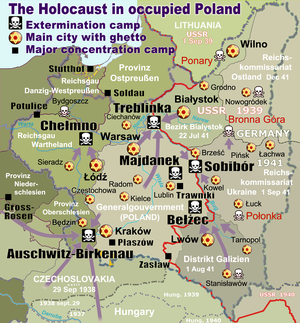Kamp pemusnahan

Kamp pemusnahan atau kamp kematian adalah kamp yang dirancang dan dibangun oleh Jerman Nazi selama Perang Dunia II (1939–45) untuk memusnahkan jutaan orang Yahudi, Slavia, Rom, komunis, dan kelompok-kelompok lain yang dianggap sebagai "Untermenschen" (bangsa rendahan). Mereka dibunuh dengan menggunakan gas atau kondisi kerja yang ekstrem dan kelaparan.[1][2]
Gagasan pemusnahan massal dengan menggunakan fasilitas tetap yang dibangun khusus untuk tujuan tersebut merupakan hasil dari ujicoba penggunaan gas beracun buatan yang dilakukan oleh Nazi selama program eutanasia rahasia Aksi T4 terhadap orang-orang yang dianggap cacat fisik dan mental.[3] Orang yang dianggap telah mengembangkan konsep kamar gas adalah Dr Albert Widmann, kepala ahli kimia Polisi Kriminal Jerman (Kripo).[4] Kendaraan gas pertama diproduksi di Berlin dan digunakan oleh Komando Lange dari tanggal 21 Mei hingga 8 Juni 1940 di kamp konsentrasi Soldau, Polandia, untuk membunuh 1.558 pasien rumah sakit jiwa.[5][6] Lange kemudian menggunakan pengalaman ini untuk mendirikan kamp pemusnahan Chelmno.[7] Widmann melakukan ujicoba pembunuhan dengan menggunakan gas di Timur pada September 1941 di Mogilev dan memprakarsai pembunuhan pasien-pasien rumah sakit lokal sembari meminimalisasi dampak psikologis terhadap anggota Einsatzgruppe.[8] Teknologi ini diadaptasi, dikembangkan dan diterapkan untuk korban jiwa dari berbagai kelompok etnis dan nasional. Genosida orang Yahudi di Eropa merupakan bagian dari "Solusi Akhir persoalan Yahudi" Reich Ketiga.[9] Peristiwa ini kini dikenal dengan nama Holocaust.[1][10]
Kamp pemusnahan juga didirikan oleh rezim fasis Ustaše di Negara Merdeka Kroasia yang bersekutu dengan Jerman Nazi. Kroasia melancarkan pembantaian orang Serbia, Yahudi, Rom, dan musuh-musuh politik Kroasia dan Muslim Bosnia dari tahun 1941 hingga 1945.[11]
Catatan kaki
[sunting | sunting sumber]- ^ a b Yad Vashem (2015). "The Implementation of the Final Solution: The Death Camps". The Holocaust. Yad Vashem The Holocaust Martyrs' and Heroes' Remembrance Authority. Diarsipkan dari versi asli tanggal 2013-11-04. Diakses tanggal 15 September 2015.
- ^ Robert Gellately; Nathan Stoltzfus (2001). Social Outsiders in Nazi Germany. Princeton University Press. hlm. 216. ISBN 978-0-691-08684-2.
- ^ Holocaust Encyclopedia (June 20, 2014). "Gassing Operations". United States Holocaust Memorial Museum, Washington, DC. Diakses tanggal 25 January 2015.
- ^ Christopher R. Browning (2007). The Origins of the Final Solution: The Evolution of Nazi Jewish Policy, September 1939-March 1942. Germany and Europe. U of Nebraska Press. hlm. 188–189. ISBN 0-8032-0392-6. Diakses tanggal 16 September 2015.
- ^ The Simon Wiesenthal Center (2006). "Responses to Revisionist Arguments".
- ^ Jewish Virtual Library (2006). "The Development of the Gas-Van in the Murdering of the Jews".
- ^ Christopher R. Browning (2011). Remembering Survival: Inside a Nazi Slave-Labor Camp. W. W. Norton & Company. hlm. 53–54. ISBN 0393338878.
- ^ Laurence Rees (2006). Auschwitz: A New History. Public Affairs. hlm. 53, 148.
- ^ " Die Endlösung der Judenfrage" – Adolf Hitler (In English, "The final solution of the Jewish problem"). Furet, François. Unanswered Questions: Nazi Germany and the Genocide of the Jews. Schocken Books (1989), p. 182; ISBN 978-0-8052-4051-1
- ^ Doris Bergen, Germany and the Camp System, part of Auschwitz: Inside the Nazi State, Community Television of Southern California, 2004–2005.
- ^ Holocaust Encyclopedia. "The Jasenovac camp complex". Washington, DC: United States Holocaust Memorial Museum. Diakses tanggal 4 February 2016.
It is presently estimated that the Ustaša regime murdered between 77,000 and 99,000 people in Jasenovac between 1941 and 1945.
Daftar pustaka
[sunting | sunting sumber]- Bartov, Omer (2000). The Holocaust: origins, implementation, aftermath. London: Routledge. ISBN 0-415-15035-3 – via Google Books.
- Cox, John K. (2007). "Ante Pavelić and the Ustaša State in Croatia". Dalam Fischer, Bernd Jürgen. Balkan Strongmen: Dictators and Authoritarian Rulers of South Eastern Europe. West Lafayette, Indiana: Purdue University Press. ISBN 978-1-55753-455-2 – via Google Books.
- Gilbert, Martin (1997). Holocaust Journey: travelling in search of the past. Phoenix. ISBN 0-231-10965-2 – via Google Books.
An account of the locations of the extermination camps as they are today, augmented by the historical information about them, and about the fate of the Jews of Poland.
- Höss, Rudolf (1959). Commandant of Auschwitz. The Autobiography of Rudolf Hoess with an Introduction by Lord Russett (PDF). Translated from the German by Constantine FitzGibbon. Cleveland and New York: The World Publishing Company. hlm. 1–311. Diakses tanggal 15 January 2015 – via direct download: 16.7 MB from Scribd.
Library of Congress Catalog Card Number: 60-5808.
- Klee, Ernst (1990). 'Turning the tap on was no big deal': the gassing doctors during the Nazi period and afterwards. Dachau Review, vol. 2. ISBN 3-9808587-1-5 – via Google Books' snippet.
- Levi, Primo (1986). The Drowned and the Saved. London: Michael Joseph. ISBN 0-7181-3063-4 – via Google Books.
- Mojzes, Paul (2011). Balkan Genocides: Holocaust and Ethnic Cleansing in the Twentieth Century. Rowman & Littlefield. ISBN 1-4422-0663-2 – via Google Books.
